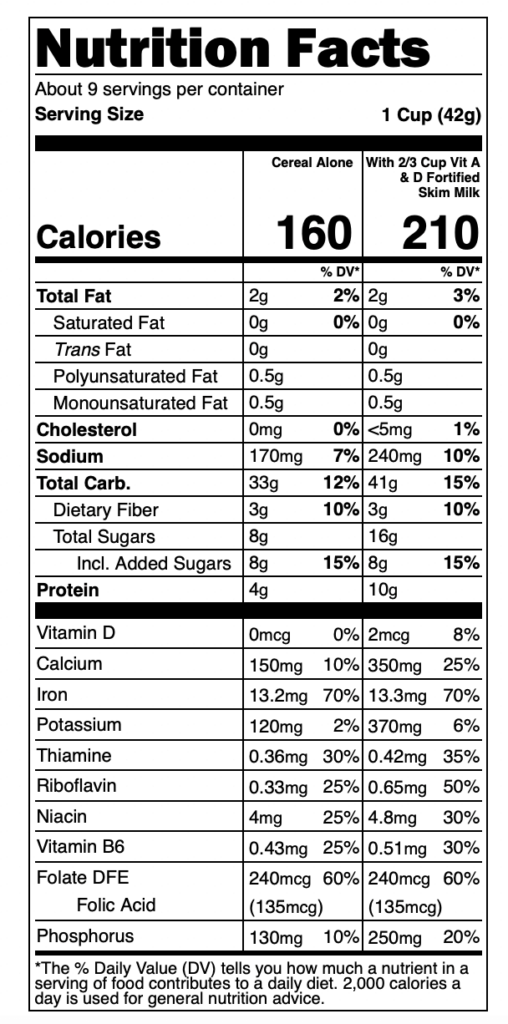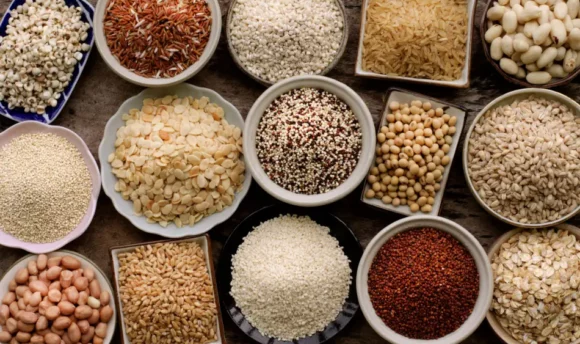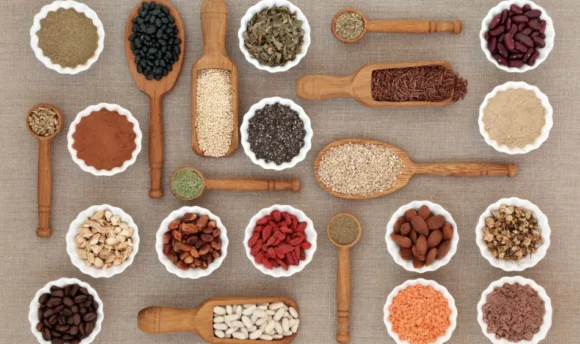Is Life Cereal Healthy? Nutritional Label, Facts
Life cereal is a popular breakfast cereal with a simple and sweet flavor that many praise for its nutrition. However, is Life cereal actually good for you? Let’s talk about it!

Many enjoy Quaker Life cereal, which is available in fun and tasty flavors such as chocolate, cinnamon, and vanilla. It is touted on the Quaker website as heart-healthy and an excellent source of B vitamins and calcium. But is it really that good for your health?
Let’s dive into more information about these nutritional claims, the potential health benefits and drawbacks of consuming Quaker Oats company Life cereal, and more!
Is Life Cereal Healthy?
Overall, Quaker Life cereal is a healthy breakfast option rich in whole grains, vitamins, and minerals, especially B vitamins, calcium, and iron. It is rich in dietary fiber, which is essential for a healthy digestive system and bowels.
Pair a bowl of Life cereal with your choice of low-fat dairy or non-dairy milk alternative to get a balanced meal rich in protein, calcium, and vitamin D as well.
Life Cereal Ingredient List
Let’s discuss some of the main ingredients used to make Life cereal.
Mainly, Life cereal contains a flour blend including whole-grain oat flour, corn flour, and whole-wheat flour. Therefore, it contains wheat and gluten.
It also has added grams of sugar. However, this is not high fructose corn syrup.
In terms of vitamins and minerals, Life cereal also contains calcium, iron, niacin (vitamin B3), thiamine (vitamin B1), pyridoxine (vitamin B6), riboflavin (vitamin B2), and folic acid (vitamin B9).
For processing and preservation, Life cereal also contains salt, baking soda, tocopherols (to preserve freshness), and annatto for color.
Vanilla Life cereal lists that it is made with “Natural and Artificial Flavors,” while the chocolate variety claims “With Other Natural Flavors.”
Thank you for your answer
Health Reporter Surveys
How Is Life Cereal Made?
Similar to other healthy cereals, Quaker Life cereal is typically made by processing whole-grain Quaker oats and other grains used into flours, combining them with flavoring and grams of sugar, then shaping and drying the cereal.
Life cereal is in the classic waffled Chex shape that is crunchy and crispy before adding milk.
Life Cereal Nutrition Facts
From carbohydrates and protein to calories and fats, let’s dive into more specifics about the nutritional information of Life cereal.
Nutrition table and label (per 100g)
| Calories/Nutrient (per 100g) | Amount |
| Calories (kcal) | 375 |
| Calcium (mg) | 350 |
| Net Carbs (g) | 52.3 |
| Fiber (g) | 6.4 |
| Sugar (g) | 19.4 |
| Fats (Total) | 4.38 |
| Protein (g) | 9.79 |
| Cholesterol (mg) | 0 |
Source: https://fdc.nal.usda.gov/fdc-app.html#/food-details/1458847/nutrients

High in carbohydrates
A one-cup serving of original Life cereal (which is approximately 42 grams) contains 33g of carbohydrates. This value includes 3g of dietary fiber and 8g of sugar.
While this is approximately two carbohydrate servings in one cup of cereal, the dietary fiber will help slow down the digestion and absorption of the carbohydrates to prevent significant spikes in blood sugars. Additionally, carbohydrates are a great energy source to power you throughout your morning.
Also, dietary fiber can help with the feeling of fullness and satisfaction with the meal. This is especially true when the cereal is paired with a healthy fat source, such as a side of nuts or seeds.
However, the Quaker Oats company Life cereal’s fiber content is a bit lower than other popular breakfast cereals. For example, Kellogg’s raisin bran contains 7g of protein per one-cup serving.
Low in protein
Unfortunately, Life cereal is relatively low in protein, with only about 4g per serving of one cup of the original flavor.
Protein is important to help build and maintain muscle and facilitate every chemical reaction in the body – and so much more! Pairing your bowl of cereal with milk or a non-dairy milk alternative, such as almond milk or oat milk, can help add a great source of protein to your meal.
Check out this resource article here to read about the best milk for weight loss and how to choose the healthiest milk.
If you prefer to consume your cereal dry, you can pair it with a glass of milk on the side or add a side of lean meat, such as turkey bacon, a handful of nuts or seeds, or a serving of eggs.
Low in calories and fats
Finally, there are only 160 calories and a mere 2g of fat in a one-cup serving of original Life cereal with its simple and sweet flavor.
Additionally, it is important to note that breakfast cereal does not contain any saturated fat.
Let’s compare this to other breakfast cereals. For example, Kellogg’s raisin bran has 190 calories per cup serving.
To keep the calories and fats of your breakfast meal low, consider skipping the 2% milk or whole milk and opting for a lower fat choice. Perhaps try adding low-fat dairy milk, such as 1% or skim milk instead.
Additionally, you can use a non-dairy milk alternative, such as soy milk or almond milk, to pair with the cereal.
Just ensure that the non-dairy milk is fortified with calcium and vitamin D to get the most nutrition in your meal.
FAQs
Life cereal is a healthy whole-grain cereal that is good for you because of its impressive nutrient profile that is rich in fiber, iron, B vitamins, and calcium. In addition, incorporating Life cereal into your diet can promote a healthy cardiovascular system.
Quaker Oats Life cereal is good for weight loss because the dietary fiber helps you feel full and satisfied longer. Additionally, a serving of Life cereal is low in calories, promoting weight loss.
Life cereal is good for diabetes. While a one-cup serving of Life cereal contains 8g of added sugars and 33g of total carbohydrates, it has some protein, fat, and dietary fiber, which slows down the digestion and absorption of sugar, preventing blood sugar spikes.
Yes, Life cereal, like many healthy cereals, contains whole-grain Quaker oats flour with about 3g of dietary fiber per serving of one cup, or approximately 42g. Fiber supports healthy digestion, cholesterol levels, blood sugar control, and more.
While it has whole-grain oat flour and corn flour, Quaker Oats Life cereal contains gluten as it has wheat-based ingredients, namely whole-wheat flour and whole grains. Therefore, it is not an appropriate cereal for those with gluten allergies or intolerances.
A Word From a Nutritionist
Life cereal is a great healthy cereal option for breakfast, especially for those who are looking to lose or maintain their weight but still have a filling and satisfying breakfast option.
Pairing your Quaker Oats company Life cereal with a protein source, such as milk, eggs, or nuts, can help boost the nutrition while making it even more satiating.
Additionally, a non-dairy milk alternative is a great way to add some protein as well, but ensure the milk alternative is fortified with calcium and vitamin D to support strong bones and teeth.
B vitamins in Life cereal, such as riboflavin, thiamin, niacin, pyridoxine, and more, are beneficial for so many areas of health.
Additionally, Life cereal, unlike many other healthy bowls of cereal, is a good source of iron which is important for blood health, including red blood cell production. Also, the cereal is rich in calcium which promotes healthy bones and teeth.
Mainly, Quaker Oats Life cereal is rich in whole grains and dietary fiber. Not only does dietary fiber support healthy and regular bowels, but it also supports lowered blood sugar and weight control, according to the Mayo Clinic.
Life cereal can also support heart health, as their website claims, since fiber can help lower blood cholesterol levels.
Increased cholesterol can build up in the blood and the arteries. This can contribute to plaque formation and increase the risk of heart attack or stroke.
Life cereal does not contain any high fructose corn syrup but does have 8g of added sugar per serving size of one cup. For comparison, a serving of Kellogg’s Fruit Loops cereal contains 12g of sugar.
Conclusion
Overall, Quaker Life cereal is one of the healthy cereals to choose for breakfast. It is a great choice because it is rich in fiber, vitamins, and minerals. In addition, this healthy cereal is low in calories and fat, which makes it an excellent option for weight management as well.
It is rich in B vitamins, such as pyridoxine or vitamin B6, as well as iron, calcium, and whole grains. However, it is low in protein.
Enjoying Quaker Oats Life cereal with low-fat milk or non-dairy milk alternatives can boost the protein nutrition for a more balanced breakfast.
Overall, consume this delicious and healthy cereal to start your day off right.

















































 Select your language:
Select your language: 








